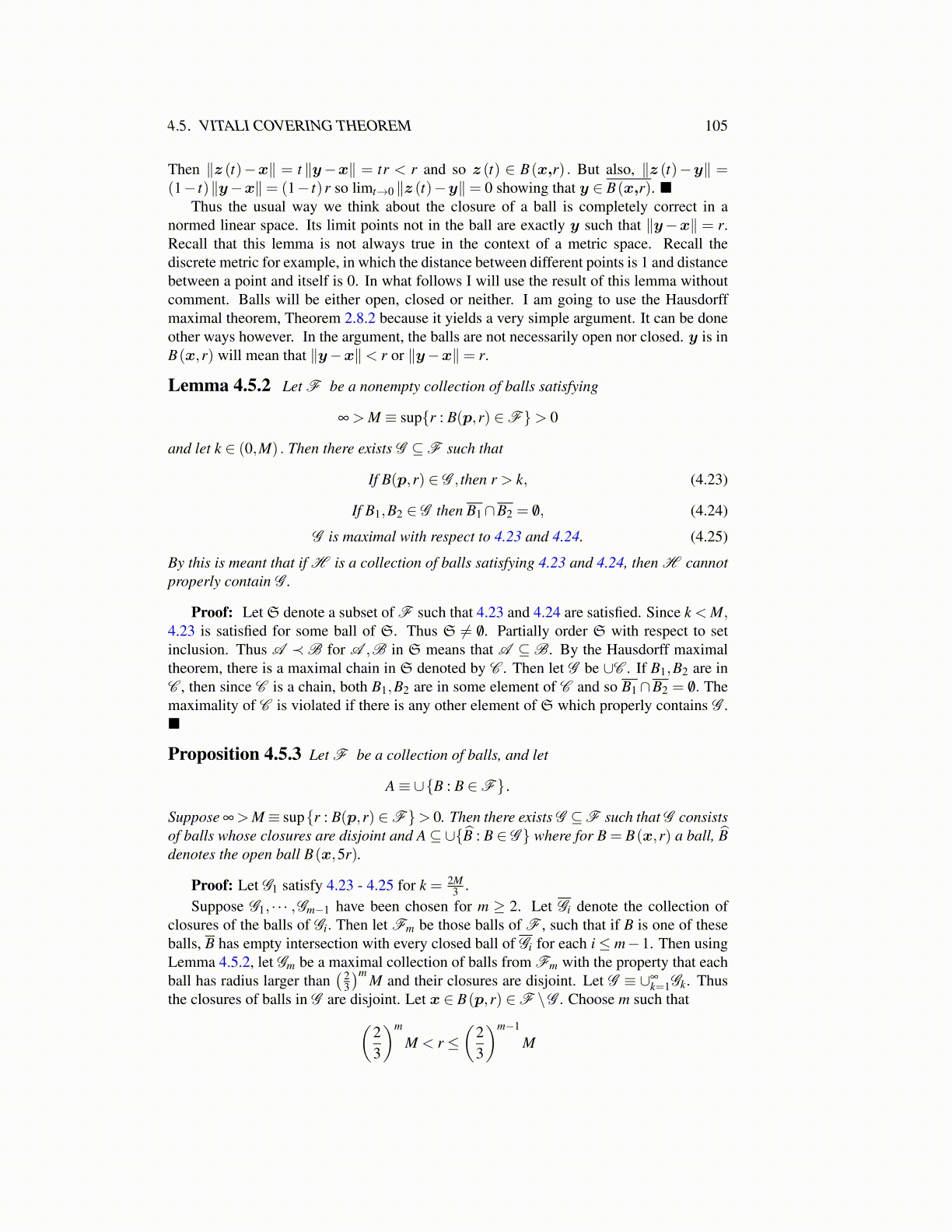
4.5. VITALI COVERING THEOREM 105
Then ∥z (t)−x∥ = t ∥y−x∥ = tr < r and so z (t) ∈ B(x,r) . But also, ∥z (t)−y∥ =(1− t)∥y−x∥= (1− t)r so limt→0 ∥z (t)−y∥= 0 showing that y ∈ B(x,r). ■
Thus the usual way we think about the closure of a ball is completely correct in anormed linear space. Its limit points not in the ball are exactly y such that ∥y−x∥ = r.Recall that this lemma is not always true in the context of a metric space. Recall thediscrete metric for example, in which the distance between different points is 1 and distancebetween a point and itself is 0. In what follows I will use the result of this lemma withoutcomment. Balls will be either open, closed or neither. I am going to use the Hausdorffmaximal theorem, Theorem 2.8.2 because it yields a very simple argument. It can be doneother ways however. In the argument, the balls are not necessarily open nor closed. y is inB(x,r) will mean that ∥y−x∥< r or ∥y−x∥= r.
Lemma 4.5.2 Let F be a nonempty collection of balls satisfying
∞ > M ≡ sup{r : B(p,r) ∈F}> 0
and let k ∈ (0,M) . Then there exists G ⊆F such that
If B(p,r) ∈ G , then r > k, (4.23)
If B1,B2 ∈ G then B1∩B2 = /0, (4.24)
G is maximal with respect to 4.23 and 4.24. (4.25)
By this is meant that if H is a collection of balls satisfying 4.23 and 4.24, then H cannotproperly contain G .
Proof: Let S denote a subset of F such that 4.23 and 4.24 are satisfied. Since k < M,4.23 is satisfied for some ball of S. Thus S ̸= /0. Partially order S with respect to setinclusion. Thus A ≺B for A ,B in S means that A ⊆B. By the Hausdorff maximaltheorem, there is a maximal chain in S denoted by C . Then let G be ∪C . If B1,B2 are inC , then since C is a chain, both B1,B2 are in some element of C and so B1∩B2 = /0. Themaximality of C is violated if there is any other element of S which properly contains G .■
Proposition 4.5.3 Let F be a collection of balls, and let
A≡ ∪{B : B ∈F} .
Suppose ∞>M≡ sup{r : B(p,r) ∈F}> 0. Then there exists G ⊆F such that G consistsof balls whose closures are disjoint and A⊆ ∪{B̂ : B ∈ G } where for B = B(x,r) a ball, B̂denotes the open ball B(x,5r).
Proof: Let G1 satisfy 4.23 - 4.25 for k = 2M3 .
Suppose G1, · · · ,Gm−1 have been chosen for m ≥ 2. Let Gi denote the collection ofclosures of the balls of Gi. Then let Fm be those balls of F , such that if B is one of theseballs, B has empty intersection with every closed ball of Gi for each i≤ m−1. Then usingLemma 4.5.2, let Gm be a maximal collection of balls from Fm with the property that eachball has radius larger than
( 23
)mM and their closures are disjoint. Let G ≡ ∪∞
k=1Gk. Thusthe closures of balls in G are disjoint. Let x ∈ B(p,r) ∈F \G . Choose m such that(
23
)m
M < r ≤(
23
)m−1
M